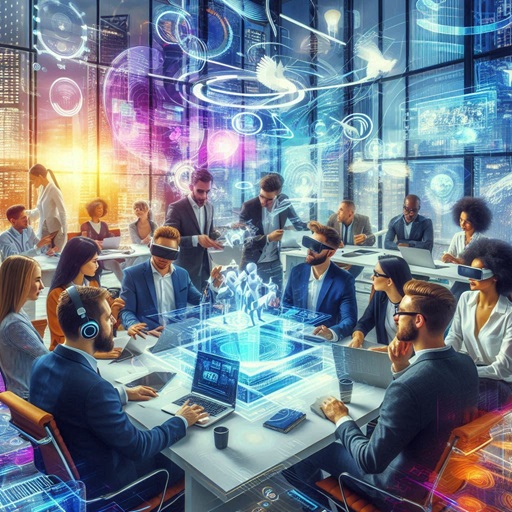The Digital Reality market is revolutionizing the way we interact with technology, blending the physical and digital worlds to create immersive experiences. This market encompasses a range of technologies, including Augmented Reality (AR), Virtual Reality (VR), and Mixed Reality (MR), each offering unique capabilities and applications. As businesses and consumers alike embrace these technologies, the Digital Reality market is poised for exponential growth, driven by advancements in hardware, software, and connectivity.
What is the Digital Reality Market?
The Digital Reality market refers to the ecosystem of technologies that create immersive digital experiences by blending the physical and virtual worlds. This market is primarily composed of three key technologies:
- Augmented Reality (AR): AR overlays digital information onto the physical world, enhancing the user’s perception of reality. Popular examples include smartphone apps like Pokémon GO and Snapchat filters.
- Virtual Reality (VR): VR creates a fully immersive digital environment, isolating the user from the physical world. VR is widely used in gaming, training simulations, and virtual tours.
- Mixed Reality (MR): MR combines elements of both AR and VR, allowing digital and physical objects to interact in real-time. This technology is often used in industrial design and remote collaboration.
The Digital Reality market is driven by the increasing demand for immersive experiences across various industries, as well as advancements in hardware such as headsets, sensors, and haptic devices.
The global Digital Reality market, which includes technologies like Virtual Reality (VR), is estimated to be valued at USD 15.9 billion in 2024 and is projected to grow to USD 38.0 billion by 2029, reflecting a robust compound annual growth rate (CAGR) of 19.1% during the forecast period. This significant growth is driven by the increasing adoption of Head-Mounted Displays (HMDs) and the rising penetration of the metaverse across various sectors. The ever-growing demand for Digital Reality systems is fueling remarkable market expansion, supported by continuous advancements in Digital Reality technology and its widespread applications across industries such as automotive, retail, healthcare, manufacturing, and aerospace & defense.
Download PDF Brochure @ https://www.marketsandmarkets.com/pdfdownloadNew.asp?id=458
Key Factors Driving the Digital Reality Market
- Metaverse Integration:
The rapid rise of the metaverse—a virtual, interconnected digital universe—has become a major catalyst for the Digital Reality market. Businesses and consumers are increasingly embracing immersive metaverse experiences, creating a surge in demand for Digital Reality technologies. - Adoption of Head-Mounted Displays (HMDs):
The widespread adoption of HMDs across industries is a key driver of market growth. These devices are becoming more affordable, lightweight, and technologically advanced, making them accessible to a broader range of users. - Technological Advancements:
Innovations in Digital Reality technology, such as enhanced graphics, faster processing speeds, and improved user interfaces, are making these systems more immersive and effective. These advancements are enabling realistic and engaging experiences, further accelerating market adoption. - Industry-Specific Applications:
The Digital Reality market is experiencing significant growth due to its expanding use in various industries:- Digital Reality in Automotive: Used for virtual prototyping, design visualization, and driver training.
- Digital Reality in Retail: Enabling virtual try-ons, interactive shopping experiences, and virtual showrooms.
- Digital Reality in Healthcare: Supporting surgical simulations, patient rehabilitation, and mental health therapy.
- Digital Reality in Manufacturing: Facilitating virtual assembly lines, employee training, and remote maintenance.
- Digital Reality in Aerospace & Defense: Enhancing flight simulations, mission planning, and equipment maintenance.
Key Trends Shaping the Digital Reality Market
1. Rising Adoption of AR and VR in Enterprise Applications
Businesses are increasingly adopting AR and VR technologies to improve efficiency, reduce costs, and enhance customer experiences. For example, companies are using AR for remote assistance, allowing technicians to troubleshoot equipment issues in real-time. Similarly, VR is being used for employee training, providing realistic simulations without the risks associated with real-world training.
2. Growth of the Gaming and Entertainment Industry
The gaming and entertainment industry is one of the largest contributors to the Digital Reality market. VR gaming, in particular, has gained significant traction, with popular platforms like Oculus Rift and PlayStation VR offering immersive gaming experiences. Additionally, AR is being used to create interactive experiences in theme parks and live events.
3. Advancements in Hardware and Connectivity
The development of lightweight, affordable, and high-performance AR/VR headsets has made these technologies more accessible to consumers and businesses. Furthermore, the rollout of 5G networks is expected to enhance the performance of Digital Reality applications by providing faster data speeds and lower latency.
4. Integration with Artificial Intelligence (AI)
AI is playing a crucial role in enhancing the capabilities of Digital Reality technologies. For instance, AI-powered algorithms are being used to improve object recognition in AR applications and create more realistic virtual environments in VR.
5. Expansion into Healthcare and Education
The healthcare and education sectors are increasingly adopting Digital Reality technologies to improve outcomes and enhance learning experiences. In healthcare, AR and VR are being used for surgical training, patient rehabilitation, and mental health therapy. In education, these technologies are being used to create immersive learning environments and virtual field trips.
Growth Drivers of the Digital Reality Market
1. Increasing Demand for Immersive Experiences
Consumers are increasingly seeking immersive experiences that go beyond traditional media. This demand is driving the adoption of AR, VR, and MR technologies across various industries, from gaming and entertainment to retail and tourism.
2. Technological Advancements
Advancements in hardware, software, and connectivity are making Digital Reality technologies more accessible and affordable. For example, the development of standalone VR headsets has eliminated the need for expensive gaming consoles or PCs, making VR more accessible to a wider audience.
3. Growing Investment in AR and VR Startups
The Digital Reality market is attracting significant investment from venture capitalists and tech giants. This funding is being used to develop innovative applications and improve the overall user experience.
4. Government Support and Initiatives
Governments around the world are recognizing the potential of Digital Reality technologies and are providing support through funding, grants, and initiatives. For example, the European Union has launched several programs to promote the development and adoption of AR and VR technologies.
5. COVID-19 Pandemic
The COVID-19 pandemic has accelerated the adoption of Digital Reality technologies as businesses and consumers sought new ways to connect and collaborate remotely. For example, VR has been used for virtual meetings and events, while AR has been used for remote assistance and virtual shopping.
Challenges Facing the Digital Reality Market
Despite its rapid growth, the Digital Reality market faces several challenges that could hinder its development:
- High Costs: The high cost of AR/VR hardware and software remains a barrier to widespread adoption, particularly for small businesses and consumers.
- Technical Limitations: Issues such as motion sickness, limited field of view, and low resolution can detract from the user experience.
- Privacy and Security Concerns: The collection and use of personal data in Digital Reality applications raise concerns about privacy and security.
- Lack of Content: The limited availability of high-quality content is a major challenge for the Digital Reality market, particularly in the gaming and entertainment sectors.
- Regulatory Challenges: The lack of clear regulations and standards for Digital Reality technologies can create uncertainty for businesses and developers.
Future Opportunities in the Digital Reality Market
The Digital Reality market is expected to continue its rapid growth in the coming years, driven by advancements in technology and increasing demand for immersive experiences. Some of the key opportunities in this market include:
- Expansion into New Industries: While gaming and entertainment have been the primary drivers of the Digital Reality market, there is significant potential for growth in industries such as healthcare, education, retail, and real estate.
- Development of 5G-Enabled Applications: The rollout of 5G networks is expected to unlock new possibilities for Digital Reality applications, particularly in areas such as remote collaboration, live streaming, and cloud gaming.
- Integration with IoT and AI: The integration of Digital Reality technologies with the Internet of Things (IoT) and AI is expected to create new opportunities for innovation, particularly in areas such as smart homes, autonomous vehicles, and industrial automation.
- Rise of the Metaverse: The concept of the metaverse, a virtual universe where users can interact with each other and digital objects in real-time, is gaining traction. This could create new opportunities for Digital Reality technologies, particularly in areas such as social networking, virtual commerce, and digital art.
- Increased Focus on Accessibility: As Digital Reality technologies become more mainstream, there is a growing focus on making these technologies more accessible to people with disabilities. This could create new opportunities for innovation in areas such as assistive technology and inclusive design.
How Industries are Leveraging the Digital Reality Market
1. Healthcare
The healthcare industry is using Digital Reality technologies to improve patient outcomes and enhance medical training. For example, VR is being used for surgical simulations, allowing surgeons to practice complex procedures in a risk-free environment. AR is being used for patient education, helping patients visualize their medical conditions and treatment options.
2. Education
The education sector is leveraging Digital Reality technologies to create immersive learning experiences. For example, VR is being used for virtual field trips, allowing students to explore historical sites and natural wonders without leaving the classroom. AR is being used to create interactive textbooks, enhancing student engagement and understanding.
3. Retail
The retail industry is using Digital Reality technologies to enhance the shopping experience. For example, AR is being used for virtual try-ons, allowing customers to see how clothing, makeup, and accessories will look on them before making a purchase. VR is being used for virtual showrooms, allowing customers to explore products in a 3D environment.
4. Gaming and Entertainment
The gaming and entertainment industry is one of the largest adopters of Digital Reality technologies. VR gaming, in particular, has gained significant traction, with popular platforms like Oculus Rift and PlayStation VR offering immersive gaming experiences. AR is being used to create interactive experiences in theme parks and live events.
5. Real Estate
The real estate industry is using Digital Reality technologies to enhance property tours and marketing. For example, VR is being used for virtual property tours, allowing potential buyers to explore homes without visiting them in person. AR is being used for virtual staging, allowing buyers to visualize how a property could look with different furniture and decor.
The Digital Reality market is at the forefront of technological innovation, offering immersive experiences that are transforming industries and enhancing the way we live, work, and play. As advancements in hardware, software, and connectivity continue to drive the growth of this market, we can expect to see even more innovative applications and opportunities emerge in the coming years.
FAQs About the Digital Reality Market
1. What is the Digital Reality market?
The Digital Reality market refers to the ecosystem of technologies that create immersive digital experiences by blending the physical and virtual worlds. This includes Augmented Reality (AR), Virtual Reality (VR), and Mixed Reality (MR).
2. What are the key technologies in the Digital Reality market?
The key technologies in the Digital Reality market are Augmented Reality (AR), Virtual Reality (VR), and Mixed Reality (MR).
3. What industries are adopting Digital Reality technologies?
Industries such as healthcare, education, retail, gaming, entertainment, and real estate are adopting Digital Reality technologies to enhance user experiences and drive innovation.
4. What are the challenges facing the Digital Reality market?
Challenges facing the Digital Reality market include high costs, technical limitations, privacy and security concerns, lack of content, and regulatory challenges.
5. What are the future opportunities in the Digital Reality market?
Future opportunities in the Digital Reality market include expansion into new industries, development of 5G-enabled applications, integration with IoT and AI, rise of the metaverse, and increased focus on accessibility.
6. How is the healthcare industry using Digital Reality technologies?
The healthcare industry is using Digital Reality technologies for surgical training, patient rehabilitation, mental health therapy, and patient education.
7. How is the education sector leveraging Digital Reality technologies?
The education sector is leveraging Digital Reality technologies for virtual field trips, interactive textbooks, and immersive learning environments.
8. What role does AI play in the Digital Reality market?
AI plays a crucial role in enhancing the capabilities of Digital Reality technologies, such as improving object recognition in AR applications and creating more realistic virtual environments in VR.



